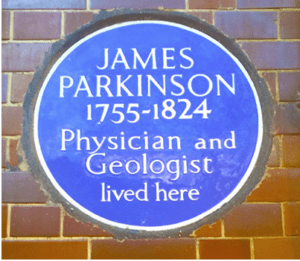 |
The man who described what Jean Charcot six decades later called “la maladie de Parkinson” was a man of many parts. In his youth he studied Greek and Latin, and also learned shorthand, which he considered an essential skill for a doctor. He was an avid collector of fossils, minerals, and shells, and went on field excursions to observe and study them. He published a book that became the standard paleontology textbook, and is one of the few men to have a disease as well as several fossil organisms named after him. He likewise studied chemistry and also wrote a book about it, became interested in geology, was a founding member of the geology society, and contributed many articles to learned societies.
James Parkinson lived in an age of upheavals ushered in by the French Revolution. He was a political activist and wrote pamphlets under his own name or under the pseudonym of Old Hubert. He supported social and electoral reform, advocating a better life of the poor, a more humane treatment of the insane, and the end of child abuse. Some of his pamphlets were viewed as inflammatory; and he became embroiled in an alleged coup to assassinate King George III and was examined under oath by the Prime Minister, Pitt the Younger, and the Privy Council. He was acquitted; but the prospect of being transported to Australia seems to have cooled his ardor and redirected his interests.
He was born in 1755 in Hoxton in the East End of London, son of John Parkinson, a surgeon-apothecary. His early life has been poorly documented and no portrait of him has survived. As was usual at the time, his medical education was brief. He spent six years as an apprentice to his father; may have briefly “walked the wards” of the London Hospital and served as a dresser; and much later, in 1785, attended the lectures of John Hunter, the great surgeon and anatomist. He became, like his father, a surgeon-apothecary (a general practitioner or primary care doctor) and worked in his father’s practice, taking it over after his death and spending most of his life working there. He never had a hospital appointment. He became a member of several medical societies in London, and in 1822 received the gold medal of the Royal College of Surgeons.
In medicine Parkinson wrote about gout, about the effects of being struck by lightning, and about hernias, for which he designed a simple truss. His was one of the earliest description of death from a perforated appendix. He took an active role in medical education and inveigled against a apprenticeship system in which one learned nothing other than to bleed the patient, give an enema, and grind up the ingredients to fill a prescription. In 1817 he published his essay on the “shaking palsy” or “paralysis agitans,” based on six cases he had observed in his own practice or on the street, making no claims to originality, for indeed the symptoms of the disease had been described since antiquity. He did not mention in his essay the patients’ mask-like facial expression, leaving that to Sir William Osler. Nor did he refer to muscular rigidity, perhaps because in those days doctors did not test for muscular tone, nor indeed touch patients except to count their pulse rate. He thought the lesion of the disease was in the upper cervical region or medulla oblongata, not a bad guess for his time; and he hoped that his essay would encourage or stimulate others to study the disease, essentially by postmortem investigations. In 1860 Jean Charcot recognized the importance of Parkinson’s work and named the disease after him. In a time when eponymous names are unpopular, his has not only survived for two hundred years but has been extended to “parkinsonism” to designate conditions that are not idiopathic but caused by other conditions such as encephalitis and drugs. During this time much has been learned about this devastating disease, new drugs have been developed to ameliorate its symptoms, but unfortunately no permanent cure has yet been found.
Further reading:
- Jefferson M. James Parkinson 1755-1824. BMJ 1973;1:601 (June 9)
- Donaldson IML. James Parlinson’s essay on the Shaking Palsy. J Roy Coll Physicians Edinb 2015;45:84
- Lewis PA. James Parkinson: the man behind the Shaking Palsy. Journal of Parkinson’s Disease.2012;2:181
- Pearce, J.M.S. Parkinson’s Disease and Its Management. Published by Oxford University Press, 1992
GEORGE DUNEA, MD, Editor-in-Chief

Leave a Reply